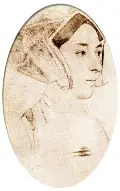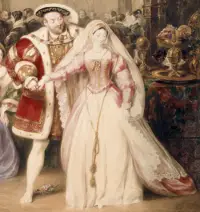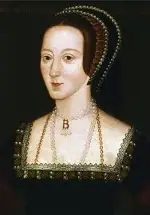Anne Boleyn
Anne Boleyn was one of England's most famous names from the 16th Century. A wife of Henry VIII, she was in some ways his inspiration for creating the Church of England. Like others who displeased the notoriously mercurial monarch, however, she met an untimely demise. 
She was born sometime in the early 1500s in Norfolk, the daughter of Thomas Boleyn and Elizabeth Howard. Among Anne's ancestors was King Edward I. Anne and her sister and brother, Mary and George, grew up in Hever Castle in Kent. Anne studied under Margaret of Austria, starting in 1513. Margaret was the daughter of Maximilian I, the Holy Roman Emperor, and was for a time the nominal ruler of the Netherlands. Under Margaret, Anne learned arithmetic, grammar, history, reading, spelling, and writing. Her two other areas of study were the outdoors–in which she learned archery, falconry, horseback riding, and hunting–and traditionally female occupations such as dancing, music, needlework, and singing. She rounded out her considerable talents by knowing how to play cards, chess, and dice. In late 1514, Anne went with Mary, sister to England's king, Henry VIII, to France, as a lady-in-waiting to Mary, who married Louis XII of France. He died not long after the marriage, and Mary returned to England; Anne stayed in France for seven years, returning to England in 1522. Thomas Boleyn had arranged for Anne to marry James Butler, her cousin in Ireland. The arrangements fell through. Instead, Anne became a regular at the royal court, along with her sister, Mary, who became a favorite of the king. Anne was the target of another nobleman, Henry Percy, but his father refused to approve of their relationship and so it ended. In the meantime, Anne had become a lady-in-waiting to Queen Catherine. Pretty, witty, intelligent, and playful, Anne was the target of many men's affections. One of those men was King Henry VIII. He had been fascinated with her older sister, Mary, but then turned his fancy to Anne. In 1528, London suffered through a great outbreak of sweating sickness, which had, several years earlier, killed Henry's brother, Arthur. Henry left London and moved around, in an effort to avoid exposure. Anne went to her family residence, Hever Castle; nonetheless, she contracted the illness, and Henry sent his personal physician to care for her. Anne survived, but her brother-in-law, William Carey, died. The queen had given birth to a healthy daughter, but the other royal births had resulted in deaths. By this time, Henry was convinced that he and Catherine would be unable to produce a healthy son, so he sought to divorce her and marry someone else (at this point, Anne). He appealed to Pope Clement VII for an annulment of the marriage to Catherine. The pope refused, in part for political reasons (not the least of which was that Catherine's nephew was Charles V, the Holy Roman Emperor) and in part because he did not want to contradict the ruling of one of his predecessors; however, the pope took his time in issuing his refusal. 
Henry and Anne were secretly married in late 1532. They were publicly married in 1533. The Archbishop of Canterbury, Thomas Cranmer, declared Henry's marriage to Catherine null and void, paving the way for the official acceptance of Henry's marriage to Anne. As well, the king's own daughter, Mary, was declared not a legitimate child of the monarch. Anne gave birth to a girl in September 1533; this girl she named Elizabeth, in honor of Henry's mother, Elizabeth of York. This girl was declared a legitimate child of the monarch. Once Anne was queen, Henry found her slightly less alluring. The qualities that had drawn him to her–her wit and intelligence and willingness to spar verbally with him–he started to find annoying in a wife. 
Henry was still very much in want of a son, and so he began to distrust Anne as he had Catherine. At the same time, many people within the realm began to voice their distrust of Anne, particularly with her role in helping the king spend large sums of money on furniture and other furnishings for the royal residences. Henry by this time had declared himself the head of the state and the church and had issued a requirement that all citizens must declare an oath of support and fealty to him in both capacities. Several high-profile individuals, including former Chancellor Sir Thomas More, had refused to take such an oath and had met with severe consequences. As well, many people blamed Anne for her role, unwitting or not, in this set of events. On Jan. 8, 1536, Catherine, long in seclusion, died. Anne was pregnant at the time (with a son) but lost the child through a miscarriage brought on by shock at Henry's life-threatening injuries suffered in a jousting tournament. The king and queen had grown apart, and Anne was rumored to be romantically involved with other men. The fact that the king was rumored, if not known, to be romantically involved with other women was not considered of equal consideration at this time. Anne, along with several men who were charged with being her paramours, was executed for treason on May 17, 1536. Her daughter went on to become Queen Elizabeth I. |
|
Social Studies for Kids
copyright 2002–2025
David White




